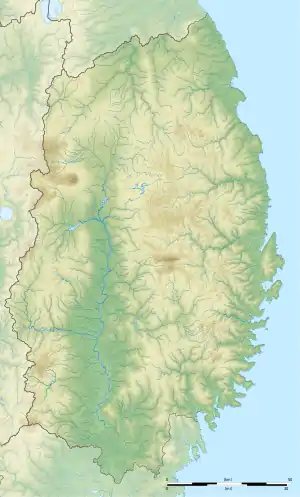Ezuriko Kofun Cluster
Ezuriko Kofun group (江釣子古墳群, Ezuriko kofun-gun) is a group of four separate sets of late Kofun period burial mounds in the city if Kitakami, Iwate, in the Tōhoku region of northern Japan. The tombs have been collectively designated a National Historic Site in 1979. [1]
江釣子古墳群 | |
 Ezuriko Kofun Cluster  Ezuriko Kofun Cluster (Japan) | |
| Location | Kitakami, Iwate, Japan |
|---|---|
| Region | Tōhoku region |
| Coordinates | 39°17′29″N 141°04′56″E |
| Altitude | 70 m (230 ft) |
| Type | kofun group |
| History | |
| Founded | 7th to 8th century AD |
| Periods | Kofun period |
| Site notes | |
| Excavation dates | 1954, 1965 |
| Archaeologists | Waseda University, Tōhoku University |
| Public access | Yes (Museum and park) |
Overview
Located on a river terrace near the confluence of the Waga River with the Kitakami River at an altitude of 70 to 90 meters, the site consists of the Nekoyazu and Naganuma sites (29 tombs), Gojōmaru site (81 tombs), and Yahata site (23 tombs), with a total of some 120 burial mounds. All of kofun are dome-shaped, with a diameter of 4.5 to 16 meters and an average height of 0.4 to 0.7 meters. Archaeological excavations were conducted in 1954 by Waseda University on a portion of the site, and identified the kofun as being from the late 7th through early 8th centuries. Further investigation was performed by Tōhoku University in 1965. The kofun contained stone burial chambers made from piled rounded river stones, the largest of which was 5 meters in length, with a central trench to hold the sarcophagus. In the Gojōmaru district, one tomb was found to contain four chambers. Grave goods included remnants of bladed instruments (swords, daggers, agricultural implements), jewelry (magatama beads, cylindrical beads, glass beads, etc.), horse fittings, and shards earthenware pottery.
References
- "江釣子古墳群" (in Japanese). Agency for Cultural Affairs.
External links
- Kitakami city home page (in Japanese)
- Kitakami tourism home page (in Japanese)
- Iwate Cultural Directory (in Japanese)